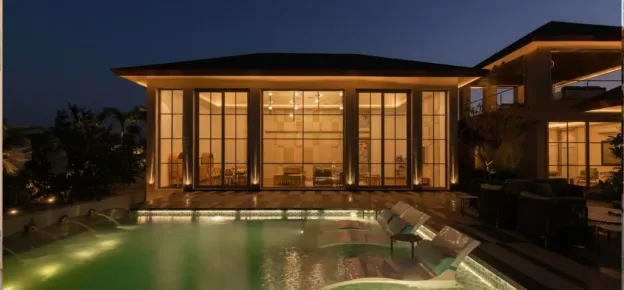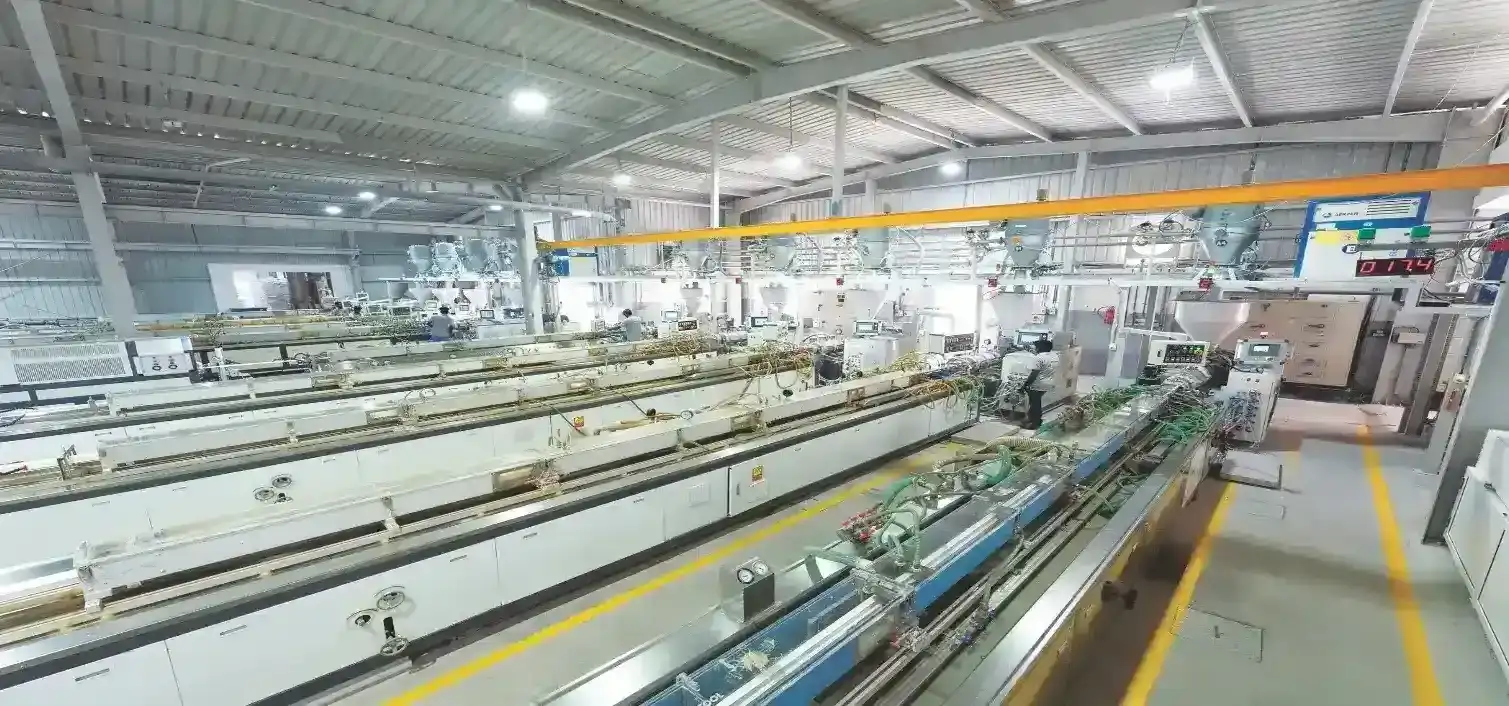Phase 5, Mohali, Punjab
This case study explores the façade design of Elixys Suites by Daawat, a boutique hospitality project based in the Chandigarh Tricity zone that demonstrates how a hybrid envelope system—composed of aluminium panels, aluminium louvres, and terracotta clay bricks—can embody both architectural expression and performance intelligence. Located in a dense urban environment, the design reconciles aesthetic rhythm, solar control, and material articulation through parametric logic and modular strategies. This article, structured for Façade Tectonics readers, delves into the design process, material selection, digital tools used, and the contextual value of the project.

Design Intent: Expressive Minimalism And Passive Performance
In an increasingly homogenized built environment, Elixys Suites stands out by adopting a vertically rhythmic and deeply textured façade. The objective was to articulate modern urban identity while delivering thermal and daylight control. The design pursues a visual interplay between fluid verticality and modular grounding, achieved through a carefully calibrated materials palette and digital design methodology.
Three Key Goals Informed The Façade Strategy:
- Vertical Emphasis & Iconicity: The hotel needed a distinct visual identity without resorting to superfluous ornamentation.
- Material Contrasts: The envelope would showcase contrasting material textures and thermal behaviors—insulation from brickwork and sleek precision, and insulation from aluminium.
- Passive Solar Strategy: Integrate elements that reduce solar heat gain and glare on the south and west elevations.
Façade Composition

- Parametric Aluminium Panel Fins
The most dominant visual element of the façade is a series of vertically arrayed aluminium composite panels, designed through different phases of inspirational conceptual sketching and final conversion through parametric scripting by allied façade partners. These panels are shaped using a curvilinear logic that responds to both visual rhythm and solar orientation. The vertical fins frame window openings asymmetrically, creating a sculptural effect that modulates across floors.
- Function: Visual identity, partial shading, modulation of fenestration
- Material: Coated aluminium in a matte silver finish
- Fixing System: Mechanical subframe to reinforced concrete with thermal breaks.
- Panel Strategy: Rationalised into modules for fabrication efficiency.
This strategy allowed the use of a double-layer aesthetic without complexity in construction. It also permitted cost-effective implementation in a non-repeating façade while avoiding monotony through subtle curvature shifts.
- Corrugated Aluminium Louvres
Behind and between the panelised elements lie corrugated aluminium louvres, in matte graphite black. These louvres serve a dual purpose: they act as a secondary shading skin and provide depth and ventilation to the façade system.
- Function: Reduce solar heat gain, provide dynamic shadow play, aid in moisture escape
- Configuration: Vertical, full-height continuous sections.
- Finish: Anodised aluminium, anti-reflective coating.
- Installation: Back-ventilated cavity anchored on a secondary framing grid.
Their crisp, repetitive geometry forms the background plane against which the silver panels project a play of solidity and void that changes with daylight. The louvres also allow air circulation behind the ACP cladding, extending the façade lifespan.

- Terracotta Clay Brick at Podium Level and Façade Length
The ground floor podium zones are wrapped in exposed terracotta clay brick, anchoring the building with tactile, human-scaled materiality. This transition from lightweight metal to solid masonry reflects a deliberate urban gesture: hospitality at the street edge must invite touch, comfort, and scale.
- Function: Material grounding, contrast, thermal mass, and insulation.
- Brick Type: Modular terracotta tiles, locally sourced.
- Bonding Pattern: Running bond with recessed mortar joints.
- Thermal Role: Acts as passive mass for diurnal temperature regulation.
The brick elements serve as both a thermal buffer and a textural counterpoint to the sleek aluminium. At eye level, they establish visual and thermal comfort, especially in outdoor dining and pedestrian zones.
Performance Considerations
- Solar Control and Orientation
The east and south façades required aggressive shading to counteract morning and midday sun. Solar studies guided the fin geometry and panel density. Areas with higher solar exposure were assigned denser panel arrangements and louvre recesses.
- Daylight And Views
Despite a narrow urban site, the vertical spacing of fins ensured unobstructed daylight access and glimpsed views through strategically positioned windows. The façade achieves a balance of privacy and transparency, avoiding direct line-of-sight into rooms while maintaining visual porosity.
- Ventilation Strategy
Operable windows are integrated behind louvred zones, allowing for cross ventilation in shoulder seasons. The open joint system between panels also permits façade ventilation, mitigating moisture buildup.
- Material Performance
- Aluminium Panels: Lightweight, corrosion-resistant, and recyclable; lifespan over 50 years.
- Louvers: Durable and low-maintenance; serve as rain screens and thermal buffers.
- Brick: Provides insulation, thermal inertia, and local identity.
Fabrication And Construction Efficiency
All façade elements were developed and exported into software by various consultants for detailed panel modulation. This ensured coordination between architectural, structural, and fabrication teams.
- Panel Optimisation: Modules rationalized into five sizes to streamline cutting and reduce waste.
- Brickwork Mock-Ups: Built on-site for joint control and texture refinement.
- Louvres: Delivered as prefabricated vertical units in parts, reducing site installation time.
Through these steps, the project balanced design ambition with practical constructability—a key tenet of contemporary façade tectonics.

Urban And Experiential Impact
The Elixys Suites façade performs not just technically, but also culturally. By layering materials and orchestrating contrasts, it achieves a dialogue between contemporary minimalism and regional warmth. For visitors, the vertical rhythm inspired by a rhythmic flame draws the eye upward, emphasizing elegance. At street level, the brick invites tactile engagement and comfort, enriching the pedestrian experience.
The hotel’s visual identity is thus inseparable from its envelope. What could have been a nondescript urban infill project becomes a case study in material integration, passive strategy, and digital precision.
Conclusion
In Elixys Suites by Daawat, the façade is not a stylistic afterthought—it is a multifunctional, expressive skin. Through a trio of carefully selected materials-anodised aluminium panels, aluminium louvres, and terracotta bricks—the design marries performance with presence and modularity with meaning.
The project demonstrates how a small-scale building can be a testbed for façade innovation, particularly when supported by parametric tools, simulation data, and local construction intelligence. As façade tectonics continues to push architecture towards integrated performance and expressive craft, projects like this point to a refined and replicable path forward.
Quick Facts:
|
















